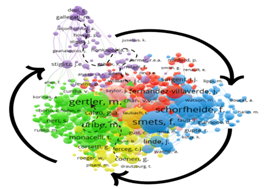Análisis bibliométrico de los modelos estocásticos de equilibrio general
DOI:
https://doi.org/10.17981/econcuc.44.2.2023.Econ.1Palabras clave:
Macroeconomía, DSGE, Bibliometría, Publicación, RedesResumen
Los modelos estocásticos de equilibrio general, o DSGE por sus siglas en inglés (Dynamic stochastic general equilibrium) se han convertido en los modelos económicos más utilizados en la macroeconomía moderna. Por lo anterior, el objetivo de este documento es analizar el origen, la evolución y el estado actual del estudio del enfoque DSGE, así como examinar las críticas y limitaciones más importantes que se le han realizado. Adicionalmente se analizó la difusión de los modelos DSGE utilizando análisis bibliométricos descriptivos y redes de citas de co-citación. Después de la crisis del 2009, la producción científica relacionada con los modelos DSGE creció de manera acelerada, en Estados Unidos y Gran Bretaña se concentra la mayor cantidad de publicaciones, por lo que un gran volumen de artículos se publica en inglés. El análisis de co-citación reveló la existencia de seis subáreas de investigación dentro el enfoque DSGE, todas centradas alrededor de los cuatro autores con mayor cantidad de citas y fuerza de enlace.
Descargas
Citas
Akerlof , G. A. & Yellen, J. L. (1985). A near-rational model of the business cycle, with wage and price inertia. The Quarterly Journal of Economics, 100, 823–838. https://doi.org/10.1093/qje/100.Supplement.823
Azariadis, C. (1975). Implicit contracts and underemployment equilibria. Journal of political economy, 83(6), 1183–1202. https://doi.org/10.1086/260388
Baily, M. N. (1974). Wages and employment under uncertain demand. The Review of Economic Studies, 41(1), 37–50. https://doi.org/10.2307/2296397
Barrdear, J. & Kumhof, M. (2022). The macroeconomics of central bank digital currencies. Journal of Economic Dynamics and Control, 142, 104–148. https://doi.org/10.1016/j.jedc.2021.104148
Bernanke, B. S., Gertler, M. & Gilchrist, S. (1999). The Financial Accelerator in a Quantitative Business Cycle Framework. In J. B. Taylor & M. Woodford, Handbook of macroeconomics, (Vol. 1, Part. C, p. 1341–1393). North-Holland. https://doi.org/10.1016/S1574-0048(99)10034-X
Blanchard, O. (2016). ¿Tienen futuro los modelos DSGE? Revista de economía institucional, 18(35), 39–46. https://doi.org/10.18601/01245996.v18n35.03
Blanchard, O. & Kahn, C. (1980). The solution of linear difference models under rational expectations. Econometrica: Journal of the Econometric Society, 48(5), 1305–1311. https://doi.org/10.2307/1912186
Brida, J., Pepeyra, J. & Devesa, M. (2008). Evaluating the Contribution of Tourism to Economic Growth. Anatolia, 19(2), 351–357. https://doi.org/10.1080/13032917.2008.9687079
Broer, T., Harbo, N.-J., Krusell, P. & Öberg, E. (2016). The New Keynesian transmission mechanism: A heterogeneous-agent perspective. The Review of Economic Studies, 87(1), 77–101. https://doi.org10.1093/restud/rdy060
Canova, F. (2014). Bridging DSGE models and the raw data. Journal of Monetary Economics, 67(C), 1–15. https://doi.org/10.1016/j.jmoneco.2014.06.003
Carlstrom, C. T. & Fuerst, T. S. (1997). Agency Costs, Net Worth, and Business Fluctuations: A Computable General Equilibrium Analysis. American Economic Review, 87(5), 893–910. Available: https://www.jstor.org/stable/2951331
Christiano, L. J., Eichenbaum, M. & Evans, C. L. (2005). Nominal rigidities and the dynamic effects of a shock to monetary policy. Journal of Political Economy, 113(1), 1–45. https://doi.org/10.1086/426038
Christiano, L. J., Eichenbaum, M. & Trabandt, M. (2018). On DSGE models. Journal of Economic Perspectives, 32(3), 113–140. https://doi.org/10.1257/jep.32.3.113
Christiano, L., Trabandt, M. & Walentin, K. (2010). DSGE models for monetary policy analysis. In B. M. Friedman, M. (Eds.) Woodford, Handbook of monetary economics (3nd ed., pp. 285–367). North Holland. https://doi.org/10.1016/B978-0-444-53238-1.00007-7
Cochrane, J. H. & Piazzesi, M. (2002). The Fed and Interest Rates: A High Frequency Identification. American Economic Review Papers and Proceedings, 92(2), 90–101. https://doi.org/10.1257/000282802320189069
Corsetti, G., Duarte, J. B. & Mann, S. (2018). One money, many markets-a factor model approach to monetary policy in the euro area with high-frequency identification. Cambridge Working Papers in Economics, 1816, 1–50. https://doi.org/10.17863/CAM.21792
Cúrdia , V. & Woodford, M. (2010). Credit Spreads and Monetary Policy. Journal of Money, Credit and Banking, 42(1), 3–35. https://doi.org/10.1111/j.1538-4616.2010.00328.x
Dammski, B. (2019). Modelos DSGE como um novo consenso em economia: uma abordagem bibliométrica [Doctoral Thesis. Universidade de São Paulo]. Digital Library USP. https://doi.org/10.11606/T.12.2019.tde-06122019-124753
Dammski, B. R., Mugnaini, R. & Duarte, P. (julho, 2018). Modelos DSGE: uma abordagem bibliométrica. Trabalho apresentado ao 6 Encontro Brasileiro de Bibliometria e Cientometria, EBBC, Rio de Janeiro, Brasil. Disponível em http://hdl.handle.net/20.500.11959/brapci/117624
De Vroey, M. (2016). A history of macroeconomics from Keynes to Lucas and beyond. Cambridge: Cambridge University Press. https://doi.org/10.1017/CBO9780511843617
Fève, O., Moura, A. & Pierrard, O. (2019). Shadow banking and financial regulation: A small-scale DSGE perspective. Journal of Economic Dynamics and Control, 101(C), 130–144. https://doi.org/10.1016/j.jedc.2019.02.001
Fischer, S. (1977). Long-term contracts, rational expectations, and the optimal money supply rule. Journal of political economy, 85(1), 191–205. https://doi.org/10.1086/260551
Galí, J., López-Salido, J. D. & Vallés, J. (2007). Understanding the Effects of Government Spending on Consumption. Journal of the European Economic Association, 5(1), 227–270. https://doi.org/10.1162/JEEA.2007.5.1.227
Gerali, N., Neri, S., Sessa, L. & Signoretti, F. M. (2008). Credit and Banking in a DSGE Model of the Euro Area. Journal of Money, Credit and Banking, 42(Suplemento 1), 107–141. Available: https://www.jstor.org/stable/40784964
Gertler, M. & Kiyotaki, N. (2015). Banking, Liquidity, and Bank Runs in an Infinite Horizon Economy. America economy review, 105(7), 2011–2043. https://doi.org/10.1257/aer.20130665
Gertler, M., Kiyotaki, N. & Prestipino, A. (2020). A macroeconomic model with financial panics. The Review of Economic Studies, 87(1), 240–288. https://doi.org/10.1093/restud/rdz032
Gordon, D. (1974). A neo-classical theory of Keynesian unemployment. Economic inquiry, 12(4), 431–459. Avaiklable: https://econpapers.repec.org/article/oupecinqu/v_3a12_3ay_3a1974_3ai_3a4_3ap_3a431-59.htm
Gregory, A. W., McNeil, J. & Smith, G. W. (2021). US Tax and Spending Shocks 1950–2019: SVAR Overidentification with External Instruments. [Working Paper, 1461]. Department of Economics, Queen's University. Available from https://www.econstor.eu/bitstream/10419/247203/1/qed-wp-1461.pdf
Gust, C., Herbst, E., López-Salido, D. & Smith, M. E. (2017). The empirical implications of the interest-rate lower bound. American Economic Review, 107(7), 1971–2006. https://doi.org/10.1257/aer.20121437
Kaplan, G., Moll, B. & Violante, G. L. (2018). Monetary policy according to HANK. American Economic Review, 108(3), 697–743. https://doi.org/10.1257/aer.20160042
Korinek, A. (2017). Thoughts on DSGE Macroeconomics: Matching the Moment, But Missing the Point? Philosophy & Methodology of Economics, 7, 159–173. https://doi.org/10.7312/guzm18672-009
Kydland, F. & Prescott, E. (1982). Time to build and aggregate fluctuations. Econometrica: Journal of the Econometric Society, 50(6), 1345–1370. https://doi.org/10.2307/1913386
León, A. (2021). Modelos de equilibrio general dinámicos estocásticos para el desarrollo turístico [Tesis Doctoral]. Universidad de Málaga, Málaga, España. Disponible en https://hdl.handle.net/10630/23604
Lindé, J. & Trabandt, M. (2018). Should we use linearized models to calculate fiscal multipliers? Journal of Applied Econometrics, 33(7), 937–965. https://doi.org/10.1002/jae.2641
Long, J. B. & Plosser, C. I. (1983). Real business cycles. Journal of political Economy, 91(1), 39–69. https://doi.org/10.1086/261128
Lucas, R. (1976). Econometric Policy Evaluation a Critique. Carnegie-Rochester Conference Series on Public Policy, 1, 19–46. https://doi.org/10.1016/S0167-2231(76)80003-6
Mankiw, N. G. (1985). Small menu costs and large business cycles: A macroeconomic model of monopoly. The Quarterly Journal of Economics, 100(2), 529–537. https://doi.org/10.2307/1885395
Mankiw, G. & Romer, D. (1991). New Keynesian Economics: Coordination failures and real rigidities. Massachusetts: MIT press.
McKay, A. & Reis, R. (2016). The Role of Automatic Stabilizers in the U.S. Econometrica, 84(1), 141–194. https://doi.org/10.3982/ECTA11574
Mertens, K. & Ravn, M. (2013). The Dynamic Effects of Personal and Corporate Income Tax Changes in the United States. American Economic Review, 103(4), 1212–1247. https://doi.org/10.1257/aer.103.4.1212
Muscatelli, A., Tirelli, P. & Trecroci, C. (February, 2004). Can Fiscal Policy Help Macroeconomic Stabilisation? Evidence from a New Keynesian Model with Liquidity Constraints. Presented at CESifo Conference on Macro, Money and International Finance, CES, Munich, Germany. https://dx.doi.org/10.2139/ssrn.534267
Niñerola, A., Sánchez-Rebull, M.-V. & Hernández-Lara, A.-B. (2019). Tourism Research on Sustainability: A Bibliometric Analysis. Sustainability, 11(5), 1–17. https://doi.org/10.3390/su11051377
Nguyen, L. (2019). Bayesian Inference in Structural Vector Autoregression with Sign Restrictions and External Instruments [Working paper]. University of California at San Diego. Available from https://acsweb.ucsd.edu/~lhn022/pdfs/LamNguyen_JMP_2nd.pdf
Parra-Alvarez, J. (2018). A comparison of numerical methods for the solution of continuous-time DSGE models. Macroeconomic Dynamics, 22(6), 1555–1583. https://doi.org/10.1017/S1365100516000821
Phelps, E. S. & Taylor, J. B. (1977). Stabilizing powers of monetary policy under rational expectations. Journal of political Economy, 85(1), 163–190. https://doi.org/10.1086/260550
Rochon, L.-P. y Rossi, S. (2018). El estado de la macroeconomía. Ola Financiera, 11(31), 100–127. https://doi.org/10.22201/fe.18701442e.2018.31.68103
Shapiro, C. & Stiglitz, J. E. (1984). Equilibrium unemployment as a worker discipline device. The American Economic Review, 74(3), 433–444. Available: https://www.jstor.org/stable/1804018
Smets, F. & Wouters, R. (2003). An estimated dynamic stochastic general equilibrium model of the euro area. Journal of the European economic association, 1(5), 1123–1175. https://doi.org/10.1162/154247603770383415
Smets, F. & Wouters, R. (2007). Shocks and frictions in US business cycles: A Bayesian DSGE approach. American economic review, 97(3), 586–606. https://doi.org/10.1162/154247603770383415
Smith, D. R. & Rivett, D. A. (2009). Bibliometrics, impact factors and manual therapy: balancing the science and the art. Manual therapy, 4(14), 456–459. https://doi.org/10.1016/j.math.2008.11.004
Stiglitz, J. E. (2017). Where Modern Macroeconomics Went Wrong. Oxford Review of Economic Policy, 34(2), 70–106. https://doi.org/10.3386/w23795
Taylor, J. B. (1979). Estimation and control of a macroeconomic model with rational expectations. Econometrica: Journal of the econometric society, 47(5), 1267–1286. https://doi.org/10.2307/1911962
Tonta, Y. & Darvish, H. R. (2010). Diffusion of latent semantic analysis as a research tool: A social network analysis approach. Journal of Informetrics, 4(2), 166–174. https://doi.org/10.1016/j.joi.2009.11.003
Van Eck, N. J. y Waltman, L. (2023). VOSviewer (versión 1.6.19) [Software]. Disponible en https://www.vosviewer.com/
Weiss, A. (1980). Job queues and layoffs in labor markets with flexible wages. Journal of Political economy, 88(3), 526–538. Available: https://www.jstor.org/stable/1831930
Werning, I. (2015). Incomplete markets and aggregate demand. National Bureau of Economic Research, 21448, 1–42. Available: https://www.nber.org/papers/w21448
Woodford, M. (2003). Interest and Prices: Foundations of a Theory of Monetary Policy. Mercer: Princeton University Press.

Publicado
Cómo citar
Número
Sección
Licencia
Derechos de autor 2023 Oscar Hernan Cerquera Losada, Fabian Adames Papa

Esta obra está bajo una licencia internacional Creative Commons Atribución-NoComercial-SinDerivadas 4.0.
Usted es libre de:
- Compartir — copiar y redistribuir el material en cualquier medio o formato
- La licenciante no puede revocar estas libertades en tanto usted siga los términos de la licencia
Bajo los siguientes términos:
- Atribución — Usted debe dar crédito de manera adecuada , brindar un enlace a la licencia, e indicar si se han realizado cambios . Puede hacerlo en cualquier forma razonable, pero no de forma tal que sugiera que usted o su uso tienen el apoyo de la licenciante.
- NoComercial — Usted no puede hacer uso del material con propósitos comerciales .
- SinDerivadas — Si remezcla, transforma o crea a partir del material, no podrá distribuir el material modificado.
- No hay restricciones adicionales — No puede aplicar términos legales ni medidas tecnológicas que restrinjan legalmente a otras a hacer cualquier uso permitido por la licencia.

 English
English
 Español (España)
Español (España)














